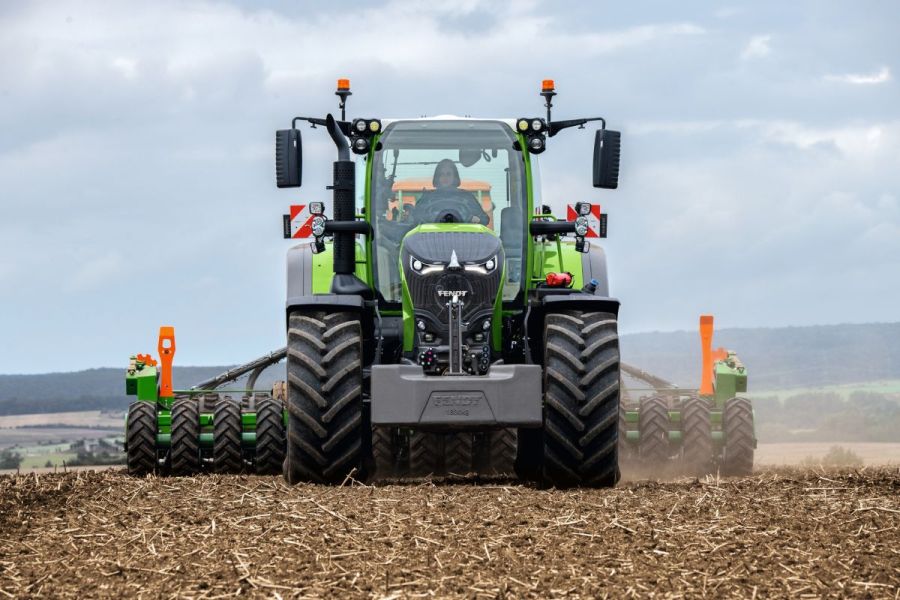Tractors are constantly being evolved and adapted to incorporate the most modern technology and to meet the changing requirements of the user. CPM explores some of the biggest launches from the past year.
By Melanie Jenkins
If there’s one piece of machinery that can help users get the most out of their other kit on farm, it’s the tractor. Whether it’s required for more pulling power, optional extras or the integration of precision technology features, manufacturers are constantly trying to refine their machines. Here are some of the latest developments and launches.
Case IH
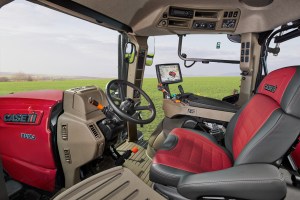
In-cab upgrades to the Case IH Puma include a phone mount, USB power ports and a tablet mount to ease in-cab management.
Case IH has recently upgraded a number of its tractor ranges, including the Puma 140-175 series. Sitting in the 155-200hp range, these models have had a redesign with Magnum-style steps to provide easier access. In-cab upgrades include phone mount, USB power ports and a tablet mount to ease in-cab management. Interior materials have been upgraded to premium-quality, automotive-type cab trim, and a new leather steering.
Puma CVXDrive models have transmission upgrades, to include additional ‘clever’ continuously variable transmission (CVT) features which focus on the driving experience by improving the shuttle and acceleration/deceleration behaviour and enhancing the drive pedal sensitivity. There’s also better Multicontroller sensitivity and position detection, with an override capability added to the cruise control pedal, which should aid users when turning at the headland. CVXDrive settings can be customised via the AFS Pro 700 display.
Case IH has also upgraded its Maxxum 115-150hp range for 2022. The top of the range six-cylinder Maxxum 150 – all other models are four-cylinder tractors – has gained 5hp in unboosted rated power to produce 150hp, meaning it moves 5hp ahead when compared with the next model in the line, the Maxxum 145.
All Maxxum models are now available with three specification packages. Maxxum and Multicontroller tractors can be ordered with the ‘selection’ package, a set of commonly sold options covering most customer requirements.
The Maxxum, Multicontroller and CVXDrive tractors can be ordered with the ‘advanced’ pack – comprising a set of technology features. Lastly, the Multicontroller and CVXDrive models can be specified with the ‘professional’ package, which provides access to the latest technology features to unlock the full potential of the tractor, according to the firm.
Claas
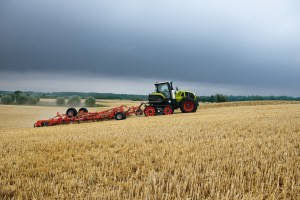
The launch of a new narrow width track should enable Claas’ Axion Terra Trac high horsepower tractors to be used in a more versatile and soil-friendly manner.
Claas has rolled out plenty of new innovations over the past year to keep any fans of their tractors excited.
The launch of a new narrow width track should enable its Axion Terra Trac high horsepower tractors to be used in a more versatile and soil-friendly manner. Designed for problem-free use in row crops, such as when spreading organic fertiliser or working with inter-row hoes, Claas now offers 45.7cm narrow tracks in addition to the current 63.5cm and 73.5cm wide rubber belts.
The Axion Terra Trac can also now be equipped with the Claas CTIC tyre inflation system on the front axle.
Claas has developed a new generation of GPS Pilot steering systems, in conjunction with Trimble, for its tractors, combine harvesters and forage harvesters. This is already available for the Claas Trion in combination with the new CEMIS 1200 terminal and is now being rolled out to other product areas and series, such as Lexion, Arion, Axion and Jaguar.
The joint development includes satellite-based steering as well as precision farming and the ISOBUS infrastructure, including task management. In addition, Trimble supplies the SAT 900 GNSS receiver specially specified for the new generation of Claas GPS Pilot.
Claas has also integrated Terranimo into CEMOS for tractors from summer 2022, meaning users now have another driving strategy available to them. According to the firm, it’s still the only self-learning, interactive driver assistance and process optimisation system available.
Terranimo is a simulation model which calculates and visualises the risk of harmful compactions. In CEMOS for tractors, this is combined with the current available parameters, such as soil type and condition, working depth, field condition (uncultivated, shallowly tilled or deep tilled), attachment, tyre type, ballasting and more.
Terranimo calculates the compaction risk separately for three soil layers and based on this risk assessment, CEMOS can provide the driver with further recommendations for ballasting and optimising the tyre pressure in order to drive in a way that protects the soil.
Fendt
Although Fendt’s new seventh generation 700 tractor had already been virtually launched earlier in the year, it’s official launch was at the firm’s international press conference in August. The machine boasts an entirely new engine and, for the first time in a tractor, eco power mode, according to Roland Schmidt of Fendt. “It’s got a six-cylinder 7.5-litre engine which is the strongest engine in this performance range of tractor. This large engine volume performs on the basis of higher torque, low engine speeds with a max of 1450Nm at 1300rpm.”
The new generation consists of five models in the 203-283hp range. The top model is the 728 Vario, which adds another 20hp via a demand-dependent control system, allowing it to achieve a max of 303hp. The extra power concept is not tied to driving speed and functions dynamically, even when PTO work is carried out at a standstill.
With a power-to-weight ratio of just 30.5kg per hp and compact external dimensions, the Fendt 728 Vario is particularly manoeuvrable and exerts as little pressure as possible on the ground. Depending on the work application, the range can be flexibly ballasted at the front, as well as at the rear on the back wheels. With an unladen weight of 8.8t and a payload of 6.2t, the model has a maximum admissible weight of 15t.
The entire drive train has been redesigned on a continuous concept from the front to back, including the rear axle. The transmission is stepless up to 60km/h and has an intelligently controlled AWD management system which automatically switches as required. This eliminates the need for manual switching when changing between field and road operations.
The range has been equipped with a new hydraulically driven integrated fan. At 56cm in diameter, it allows for a compact bonnet which enables the large steering angle of 52⁰, and its innovative design means 40% less drive power is required compared with a conventional fan and cooling system.
The fully integrated Fendt VarioGrip tyre pressure control system has been designed to increase the contact area with the ground and boosts tractive power by up to 8%, according to the firm. When driving on the road, the air pressure is raised and thus the rolling resistance is reduced meaning another 2% of fuel can potentially be saved.
The tractor and implements are operated individually via the multifunction joystick and the optional 3L joystick in FendtONE onboard. The Fendt 700 Vario is equipped with a 25.4cm digital dashboard and a 30.5cm terminal on the armrest as standard. An additional 30.5cm terminal in the headliner is available as an option.
Smart functions, such as the Fendt Guide guidance system, the automatic Fendt Section Control (SC) or the use of Fendt Variable Rate Control (VRC), are displayed as required on the individually assignable tiles on the terminals.
John Deere
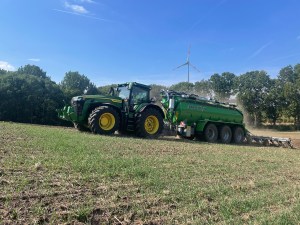
John Deere’s 8R Series now boasts the world’s first electric, infinitely variable transmission with electro-mechanical power split.
John Deere has a whole raft of new products and upgrades for users to enhance their tractors or fleet.
On the machine side, the 8R Series now boasts the world’s first electric, infinitely variable transmission with electro-mechanical power split now an option for the top of the range 8R 410 and it’s available for all three machine forms – 8R wheeled, 8RT and 8RX.
According to John Deere, it’s a significant step in the firm’s journey towards electrification. The new transmission concept, which has been developed in partnership with Joskin, offers a durable, infinitely variable transmission in the 400hp plus class.
For the new eAutoPowr, John Deere has completely replaced the hydraulic components with an electric power path. The electric drive is designed in such a way that it not only supplies the drive, but also provides up to 100kW of electrical power for external implements via 480V variable-frequency three-phase alternating current (AC).
Last year, the 6R Series was upgraded with 14 new generation models in the 110-250hp class which have become ‘smarter’. In addition, four new models have been added to the range, including the four-cylinder 6R 150, aimed particularly at mixed farms, and the six-cylinder 6R 185, a specialist transport tractor for farmers and contractors who spend more time on the road.
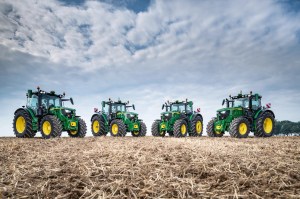
A key new feature of John Deere’s 6R series is the integrated ‘one-click and go’ AutoSetup system.
A key new feature of the range is the integrated ‘one-click and go’ AutoSetup system, which is designed to make tractor and implement settings quicker and easier. All the required settings can be pre-planned and managed in the cloud, including agronomic data, such as field boundaries, guidance lines and prescriptions. Another new feature is the E-joystick, which is particularly useful for front-loader work.
Intelligent Power Management (IPM) has been made smarter on the new 6R Series. This means that in addition to IPM functioning in transport and PTO applications, it also delivers additional horsepower in hydraulic applications as required. The four-cylinder models can now deliver up to 20hp and the six-cylinder models up to 40hp when using hydraulic fans, pumps and the most power-hungry hydraulic implements, eg wrapping balers, slurry tankers and drills.
On the precision side, John Deere has introduced AutoTrac assisted steering, which claims to be capable of reducing input costs by up to 8% and increase productivity by as much as 14%. The idea behind this feature is to improve assisted steering efficiency and John Deere claims it reduces overlap by up to 90%, be it on straight, curved or circular tracks and in low visibility conditions.
The AutoTrac set-up data – like machine and implement offsets, boundaries and guidance lines – can be safely stored and backed up in the John Deere Operations Center.
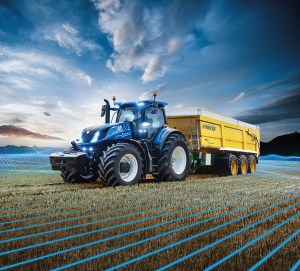
New Holland’s T7 tractor introduced the Horizon Ultra cab and the next generation of Precision Land Management (PLM) Intelligence features.
New Holland
Last year saw the launch of New Holland’s heavy duty T7 and it’s still representing the firm’s vision for agriculture and its commitment to making the advantages of intelligent farming technologies widely available to farmers. The tractor introduced the Horizon Ultra cab and the next generation of Precision Land Management (PLM) Intelligence features.
New Holland also introduced the new PLM Cygnus receiver, which is core to the enhanced auto guidance architecture on its tractors featuring PLM Intelligence. It’s designed to provide reliable position, compensating for terrain variations, and should help deliver accurate and reliable guidance.
Valtra
Valtra’s latest release is its Q Series tractors which slots into the 230-305hp range to fill the gap between the firm’s T and S Series. The 7.4-litre six-cylinder engine range, with stepless CVT transmission, consists of five models producing up to 1280Nm of torque, with the small models able to have a 20hp boost should owners want it. Maximum power is available at very low engine speeds of 1850 rpm and the maximum torque stays consistent in the range of 1500-1800rpm. The Q Series also comes with Valtra EcoPower, which the firm claims can reduce fuel consumption by up to 10%.
The past year has also seen the addition of automatic headland turn on Valtra’s fourth and fifth generation N and T Series tractors and the new Q Series. Together with Auto U-Pilot headland automation and Valtra Guide automated steering, the new SmartTurn feature completes the automation of field tasks by automatically turning the tractor in the headland.
As a result, the driver doesn’t have to touch the steering wheel at all over the entire field. This novelty aims to improve precision, save time and fuel, prevent soil compaction and should enable the driver to focus entirely on the quality of work, according to the firm.
Using SmartTurn begins by defining the boundary of the field and headland, unless these are already programmed into the Valtra Guide system. After this, the required turning radius is calibrated according to the type of implement being used and by turning the tractor sharply to the right and left. The final step is to select between two turning options: u-turn and part-field mode.
In u-turn mode, the tractor turns automatically in the headland into the adjacent undriven wayline. The tractor makes a small u-shaped turn in the headland according to the maximum turning radius. This requires a relatively large headland.
And in part-field mode, the tractor turns automatically in the headland into the third, fourth or further wayline. This requires a smaller headland than for u-turns. Both are suitable for mounted and trailed implements.
This article was taken from the latest issue of CPM. For more articles like this, subscribe here.

